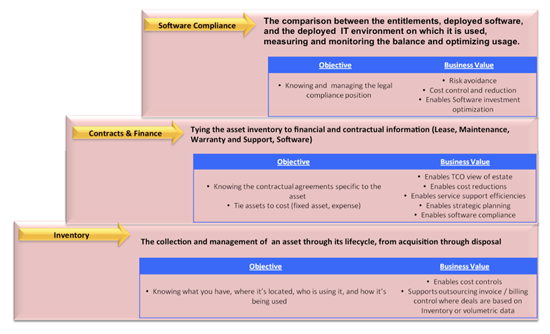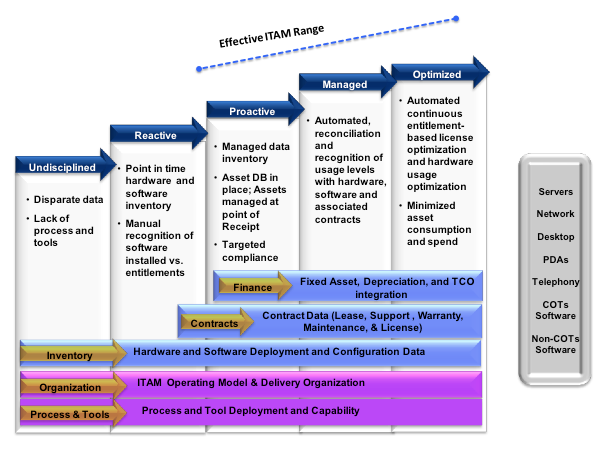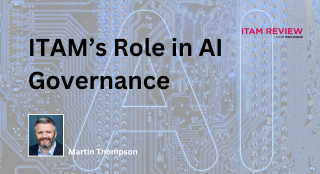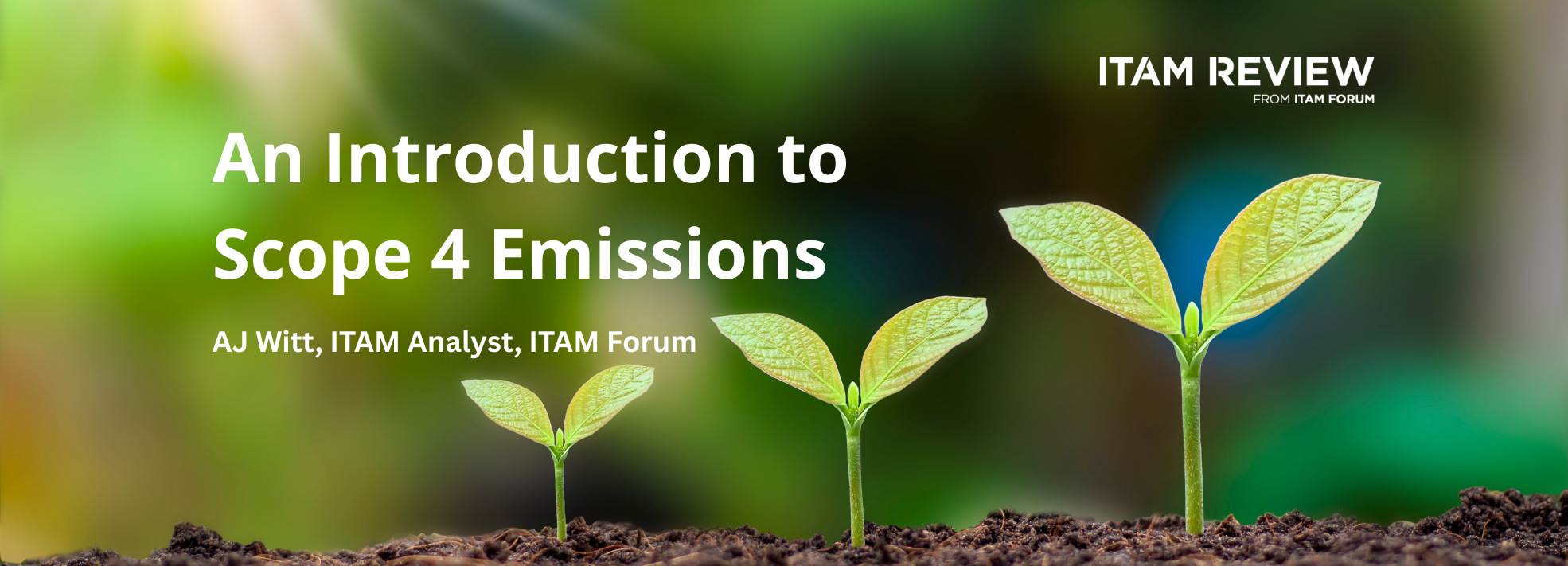How to Build Your ITAM Roadmap

How to Build Your ITAM Roadmap
This article has been contributed by Mara Zeldin of Alsbridge.
REGISTER FOR THE ITAM REVIEW NEWSLETTER TO DOWNLOAD THIS GUIDE AS A PDF.
Introduction
If you are like most IT professionals today you are under constant pressure to reduce costs. After exhausting the standard cost removal tactics, many IT leaders are now focusing on ways to reduce their hardware and software spend.
Effective IT Asset Management is the critical enabler for this approach -with effective IT Asset Management (ITAM), an organization can avoid buying hardware and software they don’t need, stop paying for maintenance and lease costs on equipment they no longer have, and make better purchasing decisions.
Effective ITAM also reduces risk, knowing your software compliance position can help mitigate unforeseen true-up costs and defuse software audits altogether.
The question now is where do you start and how much do you implement? What tools do you implement? Which processes should you focus on? Which assets should be included?
Some organizations fail because they either take on too much too soon, too little too late or don’t take on the right initiatives that demonstrate the ROI. To be successful, the organization should have an ITAM roadmap; one that is built in stages with near, mid to long range goals based around the aspects if IT Asset Management that will bring value to your organization while considering available funding.
Having a roadmap allows for a demonstration in quick wins, and allows for the proper analysis to optimize existing tools and capabilities while avoid investing in expensive tools or solutions that don’t actually address the needs of your environment.
In this white paper we lay out a framework for building your ITAM Plan, and the mechanics of implementing your ITAM Roadmap.
The ITAM Roadmap Framework
Typically the Effective ITAM range can be implemented between 12-18 months depending on the starting situation and commitment to the program. The ITAM Roadmap framework starts with understanding the building blocks of ITAM, assessing your current starting position, and setting and planning your future targets.
The ITAM Building Blocks
Each ITAM building block layers in additional capabilities and value to ITAM.

Figure 1 – Effective ITAM Building Blocks
1. Inventory – The Foundation Layer
Inventory is the foundation layer for any asset class. Whether focusing on cloud strategy, outsourcing / in-sourcing, or enterprise mobility via Bring Your Own Device (BYOD) strategies, the knowledge of what IT assets you have in house is critical to today’s strategic decisions and change enablers. Knowing the inventory is also the foundation of your ITAM initiative; some level of inventory is required for each of the ITAM initiatives.
2. Contracts & Finance – IT Cost Control & Reduction
Once a strong Inventory foundation is reached the next layer is linking and controlling contract and finance data to the asset data. This provides visibility at the asset level to your Maintenance, Warranty, Lease, Support and License agreements, and allows for cost analysis at a more granular level. At the operational level, more proactive management is introduced to control IT spend such as re-harvesting, re-purposing, and inventory/purchase controls. This layer enables Effective ITAM ROIs such as controlling IT spend, optimizing purchasing strategies, as well as laying the foundation for Software Compliance Management.
3. Software Compliance – Monitor & Control of Legal Requirements
In today’s economy there has been a marked increase in aggressive behavior from Software vendors using targeted audits as a means to gain revenue. The complexity and costs to respond to an unexpected audit not only decreases your negotiating strength with your vendors, but places risk around unforeseen fees to “true up” the license position ranging over 1 million USD in the data center software space. In one example, 10 million USD of software license compliance true up fees came into legal dispute after an outsource provider and client disagreed over terms of liability and accountability during a vendor audit.
The Software Compliance layer enables the organization to respond to an audit, control the licensing position, and avoid uncontrolled costs. This layer also enables Software License Management which includes the full capability around purchasing and deployment strategies to actually reduce the overall spend on expensive IT software.
Not all Assets are Equal
Depending on what your main drivers are, different assets may play a more or less significant role in your business and should be considered in carving out your ITAM plan scope and focus. For example, your organization may have significant liability and costs in data center equipment and software so the focus for each building block may be narrow in scope to only those asset classes. The Alsbridge Model considers the ITAM building blocks across each Asset Class; Servers, Desktop/Laptop, Network, Telephony/Mobility, Software – COTS and Software Non-COTs.
Current State and Future Targets
To create a roadmap that is meaningful to your environment requires that you understand the starting point, future goals and the gap between them. The Alsbridge Capabilities model shows the progression through realizing ITAM capabilities, with the ITAM building blocks layering across as the progression moves up the “scale”.

To assess your ITAM Current state, consider all the dimensions that enable the ITAM building blocks; namely Organization, Process and Tools. Also consider the landscape across the Asset Classes; there are different tools and processes that come into play per each major Asset Class and there may be a significant difference in your current state capabilities per Asset Class as well.
When determining your ITAM Service target requirements, consider that some of your goals may not require a full, robust ITAM implementation. The target must be weighed with the cost of service value.
Planning your Roadmap
Once you understand the current starting point and targets; create an ITAM roadmap around immediate, short term and long range goals. Below is an example of blocks of work that may be considered in the near and longer range.
Typical Initial 3-6 Month Activities
- Identify Inventory Tool set; stand up asset management database and auto-discovery tools
- Basic Set of ITAM Policies and Processes
- Establish the ITAM Operating Model – who will deliver what
- Initial Asset Inventory Baseline
Typical Transformation activities (long range goals)
- Hardware Contract data integration – warranty, maintenance, lease and support agreement
- Finance data integration
- Software Compliance – Priority Titles, Desktop, Server
ITAM Work Streams
The following outlines the basic ITAM Initiative work streams that should be addressed in any ITAM Implementation methodology. Note that if your roadmap outlines a phased approach each work stream would be iterated again during that project phase. Focus on what phase will go live and managed within the first 6 months to first year of ITAM operations.
Data – Inventory Baseline
At the heart of IT Asset Management is data management; the process and tools that help manage IT Asset Management are all heavily focused on capturing, managing and reporting on the data needed to manage the asset. The objective of the Data work stream during transition is to identify and gather the data that is to be managed and form the first baseline.
Key Stream Activities
- Identify the high level scope of data that is required for collection based on the in scope ITAM building blocks. For example, will you focus on Asset Inventory only, or is associate contract and finance data included?
- Gather detailed data requirements for all in scope data. For example if implementing Software Compliance management across server software like Oracle or MS, the data required will include hardware configuration information such as processors and cores. If there requirements to link to finance, a related Invoice or PO may be required. ITAM data requirements are also driven by Process. Walk through the process to derive the data required to be captured and at what stage.
- Based on the requirements, agree to what is to be gathered during transition, including Asset Classes and related data attributes.
- Determine the approach to gather the data. Keep in mind the method to gather the data during implementation may be different than the on-going method. Often the implementation inventory will come from multiple sources, some that will later be decommissioned. For example, existing spreadsheets and/or asset databases, and multiple discovery tool data may be used and reconciled. A physical inventory may be required during implementation. On-going collection may include a standard set of specific discovery tools.
- Gather, reconcile and baseline the asset Inventory. Make sure the acceptance of the baseline is understood and measurable; how will you validate the data is accurate? This is largely influenced by the agreed method in the step above.
Key Dependencies
- ITAM Scope
- Tools implementation time line
Operational Design
Operational Design includes the Governance and Process set required to manage and operate the ITAM Lifecycle: Policies, operational processes & procedures, ITAM Roles aligned to the organization, and defined ITAM Management & Operational reports.
Whether in-sourcing or outsourcing ITAM functions, ITAM is a cross-functional service – the ITAM participants and consumers are spread across the entire organization including business operations such as Procurement & Finance, IT Service Delivery (Applications, Data Center, Desktop/laptop etc), and Service Management (Service Desk, Incident, Problem, Change Management, Configuration Management etc). Due to the cross functional nature, ITAM Operational Design is subject to complexity.
The objective of this stream of work is to define and implement a set of ITAM lifecycle processes that effectively describe the handoffs and ensure smooth process flow through all the hands and feet that support the ITAM Lifecycle.
Key Stream Activities
Given the interactive nature of this work stream a workshop approach should be considered for steps 2-4, especially if there are multiple organizations that will take on different ITAM functions.
- Conduct a current state assessment of the existing Process, and identify gaps in ITAM capabilities and requirements.
- The Process set should be based on policies; define minimum set of Policies that will govern the ITAM lifecycle.
- Design the Operating Model. Map the key roles in the lifecycle to the current organization roles. This will assist in the Process flow design, as well as provide the blue print of hand offs.
- Gather detailed Process requirements. Process requirements are driven by the ITAM services in scope per the contract and the results of the gap analysis.
- Design and document the engagement Process; this should focus on the process handoffs and design the integrated work flow. The process design should consider the tool enablement capabilities. For example, some process steps may be automated; conversely lack of tools may require manuals steps to be in place.
- Document the Procedures and Operational playbook. The run-book should describe the daily/weekly/monthly activities at the day to day operations of the ITAM team and the interactions between ITAM delivery and business operations teams.
- Define and agree to the Operating Level Agreements, Service Level Agreements and process metrics.
- Design the reports required to support process metrics and facilitate the Operational playbook.
Key Dependencies
- ITAM Scope
- Existing Policy and process set
- Understanding of the tool capabilities
Technology
There may be different tools available to ITAM within your current IT Organization. For example, the Data Center may have monitoring software tools; a Desktop team may have a software distribution tool. These tools may also service as an auto-inventory sources or re-harvesting tools. Consider current investments when designing the technical solution.
The objective of this work stream is to holistically design the ITAM technical architecture, and make the configuration and customizations required to enable ITAM per the ITAM service requirements.
Key Stream Activities
- To achieve a holistic design, appoint a chief architect to pull together the components of the ITAM technical architecture. The important objective is to ensure there is a holistic solution.
- Design the ITAM integrated architecture. Lay out the databases, applications, systems of ITAM and the interfacing tools such as procurement and contracts.
- Detailed Technical Requirements – Gather requirements for tools based on process and data requirements. For example, if the data requires processors, cores and sockets to be tracked and managed, the Asset database must be able to support these data elements. A Gap Analysis of the tool capabilities compared to the requirements should be conducted to address configurations or customizations.
- Technical Design – based on the requirements and gap analysis, design detailed solutions within the technical landscape.
- Technical Implementation – execute any configurations or builds required.
Key Dependencies
- ITAM Scope
- Process and Data Requirements
Program Management
The ITAM Work Streams includes multiple components that can be treated as projects in of themselves. The following are some key considerations for the ITAM Program Manager.
ITAM Planning
You will need the data baseline and processes to maintain the data and manage the lifecycle in place. Conversely you want to avoid preparing the data too soon; the moment the data is base-lined if the tools and processes are not deployed to maintain it, it will be outdated almost within the day or week it is base-lined. The timing of the key work streams – Data, Operational Design and Technology – must all terminate at the same time.
ITAM & ITIL Dependencies
- In an ITIL environment, ITAM relies heavily on the Change Management throughout the life cycle. Ensure Change Management is in place at the time of go live.
- A Service Desk function should be in place so ITAM requests can be made.
- If Configuration Management is a concurrent project or already deployed, there are heavy overlaps of activity in ITAM and Configuration Management. ITAM will lay the foundation of Configuration Management; it is critical to plan these streams and identify what must be in place per the requirements.

Mara Zeldin, Alsbridge
Other People’s Business Processes
Key business functions such as Procurement or Finance may not be under the control of the ITAM program. Understanding the current state of key ITAM touch points will impact ITAM’s ability to transition and transform.
Conclusion
Scoping and planning ITAM requires an understanding of ITAM building blocks, ITAM business drivers, and current state capabilities. At the heart of a successful ITAM plan is the notion of targeting what you need, layering in requirements based on their interdependencies.
This whitepaper has been kindly contributed to The ITAM Review by Mara Zeldin of Alsbridge.
REGISTER FOR THE ITAM REVIEW NEWSLETTER TO DOWNLOAD THIS GUIDE AS A PDF.
Can’t find what you’re looking for?
More from ITAM News & Analysis
-
Broadcom vs Siemens AG - A Brewing Storm
The ongoing legal battle between VMware (under Broadcom ownership) and Siemens is yet another example of why ITAM goes far beyond license compliance and SAM. What might, at first glance, appear to be a licensing dispute, ... -
Shifting Left Together: Embedding ITAM into FinOps Culture
During one of the keynotes at the FinOps X conference in San Diego, JR Storment, Executive Director of the FinOps Foundation, interviewed a senior executive from Salesforce. They discussed the idea of combining the roles of ... -
Addressing the SaaS Data Gap in FinOps FOCUS 2.1
I recently reported on the FinOps Foundation’s inclusion of SaaS and Datacenter in its expanded Cloud+ scope. At that time, I highlighted concerns about getting the myriad SaaS companies to supply FOCUS-compliant billing data. A couple ...
Podcast
ITAM training
Similar Posts
-
The M&S Cyberattack: How IT Asset Management Can Make or Break Your Recovery
Marks & Spencer (M&S), the iconic UK retailer, recently became the latest high-profile victim of a devastating cyberattack. Fellow retailers The Co-Op and Harrods were also attacked. Recent reports suggest the rapid action at the Co-Op ... -
AI in ITAM: Insightful Signals from the Front Line
During our Wisdom Unplugged USA event in New York in March 2025, we engaged ITAM professionals with three targeted polling questions to uncover their current thinking on Artificial Intelligence—what concerns them, where they see opportunity, and ... -
How ISO/IEC 19770-1 Can Help Meet FFIEC Requirements
In the world of ITAM, the regulatory spotlight continues to intensify, especially for financial institutions facing increasing scrutiny from regulatory bodies due to the growing importance of IT in operational resilience, service delivery, and risk management. ... -
An Introduction to Scope 4 Emissions
Executive Summary For ITAM teams, sustainability is a core responsibility and opportunity. Managing hardware, software, and cloud resources now comes with the ability to track, reduce, and report carbon emissions. Understanding emission scopes—from direct operational emissions ...




